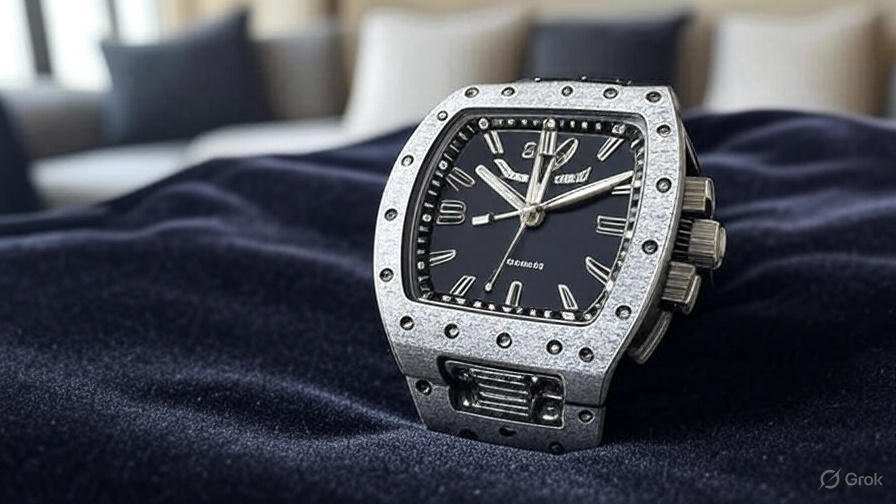In the world of luxury watches, few brands command the prestige and exclusivity of Richard Mille. Known for their avant-garde designs, cutting-edge materials, and astronomical price tags, Richard Mille timepieces are a symbol of status and innovation. However, a growing trend in the horology market has raised eyebrows: the increasing popularity of high-quality replicas of these iconic watches. This phenomenon has sparked a heated debate within the industry, pitting accessibility against authenticity and raising questions about ethics, craftsmanship, and consumer behavior.
The Allure of Richard Mille Watches
Since its founding in 2001, Richard Mille has redefined luxury watchmaking. The brand’s watches, often priced above $500,000, are crafted with materials like carbon fiber, titanium, and sapphire crystal, drawing inspiration from Formula One racing and aerospace engineering. Models like the RM 11-03 Flyback Chronograph and the RM 35-03 Rafael Nadal have become coveted pieces, worn by celebrities and athletes such as Rafael Nadal, Pharrell Williams, and Lando Norris. The brand’s limited production and technical innovation have cemented its reputation as a pinnacle of horological artistry.
Yet, the exclusivity that makes Richard Mille watches so desirable also places them out of reach for most consumers. A single timepiece can cost more than a luxury car or even a home, making ownership a distant dream for all but the ultra-wealthy. This gap between aspiration and affordability has fueled the rise of replicas, which promise the look and feel of a Richard Mille replica at a fraction of the cost.
The Rise of High-Quality Replicas
Recent reports indicate a surge in demand for Richard Mille replicas, particularly those marketed as “super clones” or “1:1 replicas.” These timepieces, often produced in factories in China, aim to mimic the intricate designs and materials of authentic Richard Mille watches. Unlike low-quality fakes of the past, these replicas use advanced materials like NTPT carbon fiber and sapphire crystal, paired with Swiss-made or high-grade Japanese movements, to achieve a striking resemblance to the originals. Prices for these replicas typically range from $699 to $2,400, a stark contrast to the six- or seven-figure price tags of genuine models.
Industry insiders note that the quality of these replicas has improved significantly in recent years, making it increasingly difficult for even seasoned collectors to distinguish them from authentic watches at a glance.
Websites like replicarichardmille.io and unitedluxury.net have emerged as key players in this market, offering replicas that boast features like skeletonized dials, tourbillon movements, and anti-reflective coating on sapphire glass. These sites emphasize their commitment to quality, often providing warranties and detailed craftsmanship descriptions to reassure buyers. For many consumers, these replicas offer an accessible way to emulate the style of high-profile figures without the prohibitive cost. For more details on available models, visit Richard Mille replica.
The Ethical Dilemma
The rise of replicas has not been without controversy. For luxury watch brands like Richard Mille, replicas represent a threat to their exclusivity and intellectual property. The brand has invested heavily in research and development to create timepieces that push the boundaries of engineering, and counterfeits undermine this innovation. “The craftsmanship and innovation behind a Richard Mille watch are unparalleled,” said a spokesperson for the brand in a recent statement. “Replicas not only dilute our brand’s value but also deceive consumers who may believe they are purchasing an authentic product.”
Watch enthusiasts and collectors echo this sentiment, arguing that replicas cheapen the prestige of owning a genuine timepiece. “A Richard Mille is more than a watch; it’s a work of art,” said Alex Turner, a watch expert and collector. “Replicas may look similar, but they lack the soul and technical mastery of the real thing.”
However, others see replicas as a democratizing force in the luxury market. For many, the appeal lies in achieving the aesthetic and social status associated with a Richard Mille watch without the financial burden. “Not everyone can afford a $600,000 watch, but that doesn’t mean they can’t appreciate the design,” said a buyer who recently purchased a replica RM 055. “These watches let people feel confident and stylish without breaking the bank.”
Spotting the Difference
As replicas become more sophisticated, distinguishing them from authentic watches has become a challenge. Experts recommend several key checks to verify authenticity. Genuine Richard Mille watches feature precise engravings, including the brand name and a unique serial number, typically located on the case back. The use of high-quality titanium ensures that authentic watches are lightweight despite their size, while replicas may feel heavier due to cheaper materials. Additionally, the intricate tourbillon movements and balance wheels, visible through transparent cases, are often less refined in replicas.
“If the engraving looks sloppy or the watch feels heavy, it’s likely not genuine,” advises a guide from LuxuryBazaar.com. “Always verify the serial number and purchase from trusted dealers to avoid being deceived.”
Documentation is another critical factor. Authentic Richard Mille watches come with extensive paperwork, including warranty cards and authenticity certificates. Buyers are advised to insist on these documents, even for pre-owned watches, to ensure legitimacy.
The Market Impact
The growing popularity of replicas has prompted action from both brands and authorities. Richard Mille, along with other luxury watchmakers, has intensified efforts to combat counterfeiting, working with law enforcement to raid factories producing high-quality fakes. In 2019, a raid on a factory known as GF (not as prominent as other replica manufacturers) disrupted the production of Richard Mille replicas, though new factories have since emerged to fill the gap.
Despite these efforts, the replica market shows no signs of slowing down. Social media platforms and online forums, such as Reddit’s r/RepTime, have become hubs for enthusiasts to discuss and review replicas, sharing tips on spotting high-quality versions and avoiding low-grade fakes. Posts on X highlight the cultural cachet of Richard Mille, with some users noting that even replicas can confer a sense of prestige in certain social circles.
The debate over replicas also raises broader questions about consumer culture and the value of luxury goods. As one user put it, “Why spend $1 million on a watch when a $1,500 replica looks just as good? It’s about the vibe, not the price tag.” This sentiment reflects a shift in how some consumers view luxury, prioritizing appearance and accessibility over authenticity.
The Future of Luxury Watchmaking
As the replica market continues to evolve, it poses both challenges and opportunities for the luxury watch industry. Brands like Richard Mille may need to adapt by offering more accessible price points or emphasizing the unique value of their craftsmanship to maintain their allure. Meanwhile, consumers face a choice between investing in authentic timepieces or opting for replicas that offer a similar aesthetic at a lower cost.
For now, the rise of Richard Mille replicas underscores a broader trend in the luxury market: the tension between exclusivity and inclusivity. While replicas may never replicate the prestige of owning an authentic Richard Mille, they have undeniably carved out a niche, appealing to those who value style and craftsmanship but lack the means to invest in the real thing. As the debate continues, one thing is clear: the allure of Richard Mille, whether genuine or replicated, shows no sign of fading.
Conclusion
The surge in demand for Richard Mille replicas reflects a complex interplay of aspiration, economics, and ethics in the luxury watch industry. While these high-quality imitations offer an accessible alternative for those drawn to the brand’s iconic designs, they also challenge the core values of authenticity and craftsmanship that define Richard Mille’s legacy. As technology continues to blur the line between genuine and replica, the industry faces a pivotal moment. Will luxury watchmakers double down on exclusivity, or will they find ways to bridge the gap between aspiration and affordability? For now, the replica market serves as both a mirror and a disruptor, reflecting consumer desires while reshaping the landscape of luxury horology. As this trend evolves, it will undoubtedly continue to spark debate, innovation, and reflection on what it truly means to own a piece of timekeeping history.










